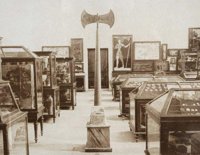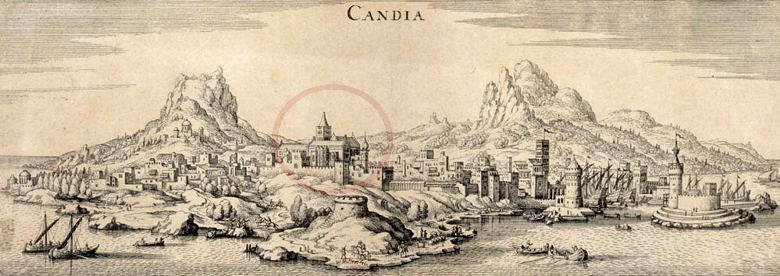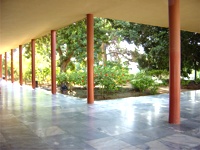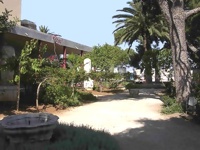The Museum collections began being put together in the late 19th century, when Crete was still under Ottoman rule. In 1878, during a period of temporary calm following the insurrection of the Cretan people, when the Turkish government granted certain freedoms and Crete was acknowledged as A privileged and autonomous province of the Ottoman state, a group of distinguished citizens established the Educational Association of Herakleion with a view to founding schools and developing Greek education and culture on the island.

The first exhibition hall of the museum
ln 1883 under its new chairman, the antiquity-loving doctor Joseph Hadzidakis, the Association expanded its activities and having secured a special written decree from the Sultan, obtained recognition as a quasi - official archaeological authority and devoted itself to collecting Cretan antiquities with a view to establishing a Cretan Museum. Donations of local private collections were gradually added to the artefacts gathered by the Association.
This important archaeological material was originally housed in two rooms in the churchyard of the Cathedral of Aghios Minas and in this way was saved thanks to the actions of Hadzidakis, during the turmoil of the 1896 uprising. ln 1899 the struggles of the Cretan people for freedom were vindicated. And the autonomy of Crete was recognised under the protection of the four Great Powers. The Association ceded the Cretan Museum to the Cretan Polity, and an archaeological law was passed immediately by which two archaeological districts were designated under ephors Ioseph Hadzidaikis and Stephanos Xanthoudidis.

Depiction of Herakleion (Candia) in a drawing by Captain J.Spratt (1852).
The splendid Venetian church of Aghios Frankiskos (St. Francis) is a major landmark. Many years later, the Archaeological Museum of Herakleion was built on the same site, near the ruins of this church.
ln 1900 with the proclamation of the autonomy of Crete, the Museum’s significant acquisitions were housed in part of a barracks building, which today accommodates the Prefecture of Iraklion. At the same time intense excavation activity had been undertaken by
the Greek ephors and by foreign scholars and archaeological schools who showed a lively interest in Cretan antiquities. The growing number of splendid finds required the construction of a special building to accommodate them. Thus between 1904 and 1907 a large open - plan museum was built and one year later, a rear porch (opisthodomos) was added. In conformity with the general plan of a Classicist order drawn up by Panagiotis Kavvadias and the famous architect - archaeologist Wilhelm Dorpfeld, the west wing and the Classical - style facade were added in 1912. Nevertheless this building, from the point of view of space, functionality and quality of construction was, from the outset, totally inadequate to provide secure housing and exhibition space for the Museum's unique archaeological treasure, which kept growing with the addition of important finds from excavations. Immediately after construction of the Museum and especially after 1913 - 1914 when Crete became part of Greece, the demand was put forward to construct a more suitable, modern Museum. After Hadzidakis' retirement in 1923 and Xanthoudidis untimely death in 1928 the issue was raised again by the next active ephor Spyros Marinatos. In the meantime, the building had suffered further serious fatigue after successive earthquakes. In I934, work began on the new building in which the Museum is housed to this day. Between 1937 and the outbreak of World War II, it was virtually completed.
It was built on the same prominent site as the previous building, which was demolished, at a central location in the city of Herakleion, on the inner side of the eastern Venetian wall near the ruins of the famous Venetian church of Aghios Frankiskos. The anti - seismic building, with a total area of 8.800 sq.m, built to a design drawn up in 1933 by architect Patroklos Karantinos (1903 - 1976), is one of the most significant products of the modem architectural movement in Greece

during the interwar period. It is an avant-garde building in terms of both style and functionality, with applications that were innovative for their time on a global scale, such as the special lighting system with the use of light wells. It is regarded as one of the most important international works of the "new architecture". A characteristic fact is that, in a significant early post - war catalogue, it was assessed as being one of the eight most representative European "exhibition and recreation buildings" among museums in Italy, Finland, Spain and Austria. Even though it is not particularly well known and despite the fact that the 1933 design was not applied in full, the Herakleion Museum building constitutes a top-ranking example of 20th – century Greek architecture and a point of reference for significant works by other important architects, such as the National Gallery in Athens, the Museum in loannina, etc.


The re - exhibition of the ancient artefacts began in 1951, overseen by the then ephor Nikolaos Platon; at the same time new storage facilities were built. In 1952 the main exhibition had already been presented. In I964, the next ephor, Stylianos Alexiou designed a new wing that included four additional halls.
The Museum today comprises twenty halls that are open to the public, the Scholarly Collection that is open to researchers and scholars alone and also contains significant finds, storage areas and conservation workshops. Exhibits from the Neolithic, Minoan. Geometric and Archaic periods and sculptures from the Hellenic and Roman periods can be found on the ground floor. On the upper floor are the Minoan wall paintings and, since 2002, the exhibition entitled "The King Minos" featuring gold Minoan signet and other rings.
The Archaic. Hellenistic and Roman small artefacts and the Giamalakis Collection, which were once displayed in two halls on the upper floor, have been withdrawn, owing to the many travelling exhibitions.
Despite the extreme importance of its works from the Hellenic period, the singularity of the Museum lies in the wealth of Minoan masterpieces that constitute its primary exhibition material.

The harvesters' vase
(Agia Triada)
The more than 10.000 artefacts found in Minoan palaces, villas, settlements, shrines and cemeteries illustrate the panorama of the Minoan world and demonstrate its amazing diversity. Among them, emblematic and celebrated works can be singled out, such as the snake goddesses, the bull's head rhyton, the Prince with the Lilies, the bull-leaping fresco, the gold bees, the "Parisienne", the Harvesters' Vase and many others.
It is obvious that, as almost fifty years have elapsed since the last reorganisation, the Museum was urgently in need of radical renovation, as regards both the building and the exhibition. The remodelling of the building includes extensions, additions and modern infrastructure works and is already taking place on the basis of plans drawn up by architect Alexandros Tombazis. This will be followed by the re-exhibition of old collections and new finds, structured into chronological and thematic units in accordance with modern museological specifications, so that the significance, development and continuity of the ancient Cretan civilisation over a period of seven millennia, from the 7th millennium BC to the 4th century AD, can be displayed with emphasis on the singularity of the Minoan collection.